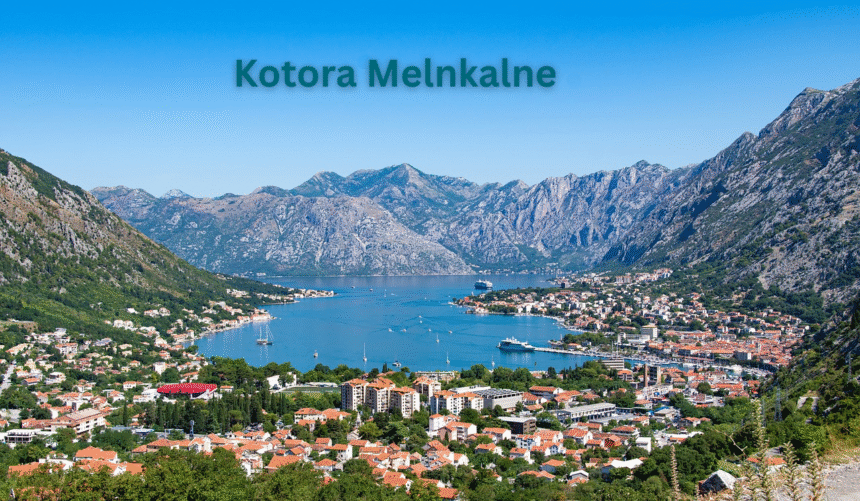Kotora Melnkalne — a quick picture
Kotora Melnkalne is a name that blends place and landscape: a compact way to think about Kotor and the mountains that rise behind it. In practical terms, this corner of Montenegro sits where steep limestone slopes meet the calm inlet known as the Bay of Kotor. The terrain shapes local life — fishing lanes, narrow alleys, and fortifications perched where the slope meets the sky.
In this guide I’ll combine clear directions, practical tips, and a few local details that make time in the town richer. If you’re deciding whether to stop for a day or stay several nights, the next sections will help you plan.
Where is Kotora Melnkalne — and how to reach it
Kotor lies on Montenegro’s western coast, at the innermost point of the Bay of Kotor (Boka Kotorska). Most visitors arrive by road: the coastal drive from Dubrovnik takes about 1.5–2 hours depending on border crossing times, while transfers from Podgorica are longer but scenic. Buses, private shuttles, and car hires are common options; choose private transfer if you want fewer stops and a fixed schedule.
If you arrive by sea, ferries and local boats link Kotor to nearby towns such as Perast and small islands like Our Lady of the Rocks. In high season, boat trips are frequent; in shoulder months, book ahead or check the local timetable.
A compact history that matters to visitors
Kotor’s built environment reflects many layers. The town grew on trade and defence: Illyrian and Roman settlements preceded the medieval city, and long periods under Venetian rule shaped the architecture you still see today. The town’s medieval core and the surrounding landscape earned UNESCO World Heritage status in 1979 for its cultural and natural value. These facts explain why preservation is central to visitor experience — streets, squares, and churches carry details that matter to historians and casual visitors alike.
When you walk through the Old Town, notice the mix: Romanesque churches, Venetian palaces, and fortified walls climbing the mountain. Each layer supplies a reason to slow down, whether you like architecture or simply enjoy quiet passages and shaded squares.
The Bay of Kotor — shape, light, and the best viewpoints
Boka Kotorska has a fjord-like shape that traps light and creates dramatic reflections on calm days. That geography gives photographers and sightseers multiple vantage points: sunrise highlights the eastern slopes while late afternoon emphasizes the cliffs above the bay. For a compact view, the walk up the San Giovanni (St. John) fortress steps rewards effort with a sweep of the bay and the old town tucked beneath the walls.
To plan your photo times: mornings work for calm water shots; golden hour captures warm stone against the sea. If you prefer lower crowds, aim for early mornings in shoulder seasons (spring or autumn) — you’ll avoid tour-boat traffic and enjoy milder temperatures.
Old Town highlights — what to look for first
Start at the main square and let the narrow lanes guide you. Key places to note include St. Tryphon’s Cathedral — a Romanesque landmark dating back centuries — and the Maritime Museum, which contextualizes Kotor’s seafaring past. The Clock Tower marks a convenient meeting spot; nearby cafes let you watch daily life while planning the next stop.
Walk slowly. Many of the small churches and palaces do not advertise themselves loudly, but they reward curiosity with carved stonework and quiet courtyards. If you enjoy small museums, allow an hour for the maritime exhibits and another hour to climb part of the fortress for views.
Fortresses and hikes — what to expect
The fortress path to the top is steep but well trodden; you’ll pass ruins, small chapels, and viewpoints that get progressively broader. Because the ascent exposes you to sun and wind, pack water and wear sensible shoes. Time the walk for early morning or later afternoon to avoid midday heat in summer. The work required pays off with a panoramic comprehension of how the town fits into the bay basin.
If you prefer gentler outings, choose the lower sections of the city walls or short coastal walks near Dobrota. For any hike, check local signage and ask at your accommodation about recent trail conditions.
Day trips that widen the experience
Kotor’s small size makes it an easy base for short excursions. The most common outing is to Perast, a quiet baroque town ten minutes away by car or boat. Its stone houses face the bay, and its waterfront cafes give you a slower rhythm than the main town. Just offshore, boats shuttle visitors to the small island church Our Lady of the Rocks, built on an artificial islet centuries ago. The interior murals and maritime votive offerings reflect the seafaring roots that once supported the entire region.
Another worthwhile route follows the coast to Herceg Novi, a breezy town near the Croatian border known for gardens, open-air stairways, and the Kanli Kula fortress. If you prefer inland landscapes, head east toward Skadar Lake National Park, where freshwater ecosystems replace saltwater views. Each destination fits comfortably into a half-day or full-day plan, depending on how much you want to linger.
Food and festivals — everyday culture in motion
Montenegrin cuisine blends coastal and mountain traditions. In Kotor, seafood dominates menus: grilled calamari, black risotto colored with cuttlefish ink, and fish stews thickened with tomato and olive oil. Pair those dishes with local wines from the Crmnica region or try a glass of rakija, the ubiquitous fruit brandy offered as a gesture of welcome. Small bakeries serve burek — flaky pastry filled with cheese or spinach — which works well for early starts before hikes.
Cultural life peaks during events such as Boka Night, a summer boat parade where illuminated vessels glide around the bay, and the Kotor Carnival, which fills the old town with music, masks, and dance. Spring and autumn bring smaller festivals focused on art, film, and local crafts. Checking the event calendar before you travel helps you decide whether to embrace the crowds or seek quieter days afterward.
Practical tips that make a visit smoother
Where to stay
Inside the old town, guesthouses occupy restored stone buildings and keep you within walking distance of everything. Outside the walls, newer hotels along Dobrota’s waterfront provide views and easy parking. Choose according to your pace: inside for atmosphere, outside for space and calm nights.
Best times to visit
Late April to early June and mid-September to October strike the best balance of weather and manageable crowds. July and August bring cruise ships and higher prices, though the evenings still carry charm once the day visitors leave. Winters are mild but quieter, with some businesses closing for the season.
Money, safety, and connectivity
The euro is Montenegro’s currency, and most cafes accept cards. Tap water is safe to drink. The old town’s narrow streets require awareness of uneven stone surfaces, especially after rain. Internet coverage is reliable, and many restaurants offer free Wi-Fi for travelers sharing updates or photos.
Sample two-day itinerary
Day 1: Morning arrival and check-in. Spend late morning wandering the old town squares, visiting St. Tryphon’s Cathedral and the Maritime Museum. After lunch, climb part of the fortress steps for a sunset view, then dine on seafood along the harbor.
Day 2: Take a morning boat to Perast and Our Lady of the Rocks. Return by early afternoon for a walk along Dobrota’s promenade, stopping for coffee at local bakeries. Evening is perfect for relaxed shopping or a quiet drink at the edge of the bay before departure.
This structure keeps travel light yet satisfying; extra days open time for Herceg Novi or Skadar Lake without rushing.
Frequently asked questions
How many days should visitors plan for Kotor?
Two full days cover highlights comfortably. Add a third if you want multiple day trips or more beach time.
Is it safe for solo travelers?
Yes. Kotor is considered one of Montenegro’s safer destinations. Normal awareness — securing valuables and avoiding unlit paths late at night — is sufficient.
What language is spoken?
Montenegrin is official, but English is widely understood in tourist areas.
Is it family-friendly?
Yes. Many accommodations welcome families, though stroller navigation can be tricky on the cobbled streets.
What should travelers pack?
Light clothing, good walking shoes, a refillable water bottle, and a light jacket for evenings near the bay.
Conclusion — why Kotora Melnkalne leaves a mark
Kotora Melnkalne brings together history, landscape, and calm reflection within a compact area. Its walls tell the story of maritime trade and cultural crossroads, while its mountains and bay stage a daily play of light that changes by the hour. The mix of heritage, manageable scale, and warm local rhythm creates the kind of place that travelers remember for small moments rather than grand gestures.
Spending time here means hearing bells echo off stone, tasting food shaped by both sea and soil, and watching sunset colors settle across the bay. Whether you stand on the fortress steps or at a quiet waterfront cafe, Kotor’s balance of energy and stillness reminds visitors why this corner of Montenegro continues to attract those looking for authentic coastal character.






